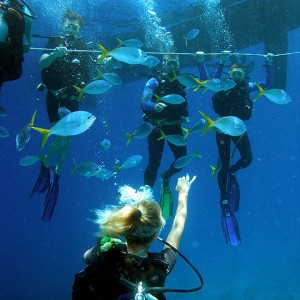We’ve all seen the advertisements: Video of an epic snowboarding run down fresh powder, catching the perfect wave and getting caught in a barrel, or that adrenaline filled moment as someone jumps out of a plane and plunges through the sky; all of this with breathtaking HD quality from an in-your-face point-of-view. The quality and availability of HD Action Cameras such as GoPro, Sony Action Cam, TomTom Bandits, and may more mean that increasingly, people are filming every aspect of every trip’s activities, so that they can relive those amazing moments online and with friends. Many of our introductory and certified divers take action cameras on their dives on the Great Barrier Reef, and they in-turn produce some amazing images. In this two-part blog, we’ll examine some tips that will help divers get those much sought-after photos, while at the same time staying safe and protecting the reef ecosystem. Up First: Some advice for our Introductory Divers.
As scuba instructors on the Great Barrier Reef, our goal is to help people enjoy their dives while keeping them as safe as possible. When you come aboard Passions of Paradise for an introductory scuba dive, chances are it will be one of your first dives; many people visiting us have never been diving before. It is important to listen to the safety briefing and the dive briefing, and take the information to heart, especially regarding use of cameras.
Tip#1: Get comfortable
Novice divers have differing levels of swimming ability; even confident swimmers can find the process of breathing underwater and manoeuvring with the gear to be challenging at first. So when you first jump into the water, set your camera aside. Focus on performing the safety skills with the instructor, and practice breathing through the regulator. For about the first 10 minutes of the dive, get used to swimming underwater and feeling weightless, especially if it is your first ever dive or you are not that confident a swimmer.
Tip #2: Stay with your Instructor
The law in Queensland requires uncertified scuba divers to be within immediate reach of the accompanying underwater instructor, usually with one metre. In addition, the instructors usually know where to find photogenic marine wildlife such as clownfish, giant clams, corals, and turtles. So if you are swimming with your camera, pay attention to the instructor—they quite often are taking you in the direction of something that will make a great photo.
Tip #3: Pay attention to your surroundings.
We want the reef to be here forever. So while you are diving and taking photos, do your part to ensure the long-term sustainability of the reef by staying away from the coral and marine wildlife. If divers are too busy trying to take photos, they make kick the coral, which can cause breakage and damage. Remember: When people go to get a licence to dive, they have the opportunity to return to scuba training upon completion of their certification and do specialty courses in underwater photography and filming. The point: Focus on diving first, photography second.

